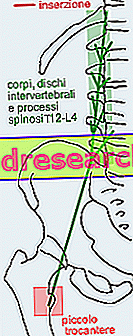
The large psoas muscle is divided into a superficial part and a deep part. It is located in front of the square muscle of the loins. The superficial part originates from the lateral faces of the bodies of the last thoracic vertebra (T12) and of the first four lumbar vertebrae (L1-L4) and from the intervertebral discs interposed. The deep part originates from the transverse processes of the 1st-5th lumbar vertebra.
It is inserted on the medial surface of the small trochanter of the femur. It joins with the iliac muscle to form the ileopsoas muscle.
The large psoas muscle is a thick, fusiform, and multiarticular muscle that allows the thigh to flex over the pelvis. With its action, the thigh rotates externally, adducts it, and participates in the lateral inclination of the bust.
ORIGIN The superficial part: originates from the lateral surfaces of the bodies of the 12th thoracic vertebra and of the 1st-4th lumbar vertebra and from the intervertebral disks interposed. The deep part originates from the coastal processes of the 1st and 5th lumbar vertebrae |  |
| INSERTION Medial surface of the small trochanter of the femur | |
| ACTION It flexes the thigh on the pelvis, it gives it and the wheel externally, inclines the trunk laterally | |
| INNERVATION Specific branches of the lumbar plexus and femoral nerve (L1-L3) |
| Upper limb | Lower limb | Trunk | Abdomen | Articles |



